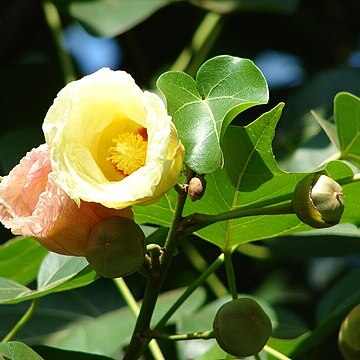Trees or shrubs; plants glabrous or pubescent, with an indumentum of scales or stellate hairs. Leaves simple; stipules very slender; leaf blade ovate, entire or lobed, margin entire, often with abaxial foliar nectaries. Flowers solitary (rarely in small cymes), axillary, large and showy. Epicalyx lobes 3-5, minute, caducous after flowering, sometimes subtended by 3-merous nectaries. Calyx cup-shaped, truncate to 5-lobed. Corolla campanulate; petals 5, yellow [or white or pink], with or without dark purple basal spot. Staminal column antheriferous throughout; apex 5-toothed, usually included. Ovary 5-loculed; ovules several per locule; style rod-shaped, 5-grooved; stigma 3-5-sulcate or rarely 3-5-lobed, decurrent. Capsule 3-5-locular, globose or pyriform, leathery or woody, dehiscent or indehiscent, sometimes slightly fleshy. Seeds 3 to many per locule, obovoid, glabrous or hairy.
Shrubs or small trees, glabrous or lepidote or stellate-pubescent. Leaves long-petiolate, the stipules early caducous, the blade entire to 3-to 5-lobed. Flowers axillary, solitary, or forming terminal racemes or panicles by reduction of the upper leaves; epicalyx of 3-5 distinct, ovate to filiform bractlets, these persistent or early caducous; calyx cupuliform, usually truncate and 5-denticulate, persistent; corolla large, campanulate, the petals 5, adnate to the base of the staminal tube; staminal tube dentate or lobulate at the apex, filamentiferous on most of its length, the filaments short, the anthers hippocrepiform; ovary 5-locular, the locules 3-or 4-ovulate; style unbranched, clavate, bearing 5 stigmas. Capsules ligneous or leath-ery, indehiscent or tardily dehiscent; seeds few in each locule, obovoid or turbinate, glabrous or pubescent; cotyledons black-punctate.
Flowers solitary, axillary or forming terminal racemes or panicles by reduction of the upper leaves.
Ovary 5-locular, loculi 3–4-ovulate; style not branched, clavate.
Fruit woody or somewhat fleshy, not lobed, indehiscent.
Calyx cupuliform, truncate, persistent.
Seeds sericeous or glabrous.
Epicalyx of 3–5 bracts.
Small trees or shrubs.
Leaves lepidote.

